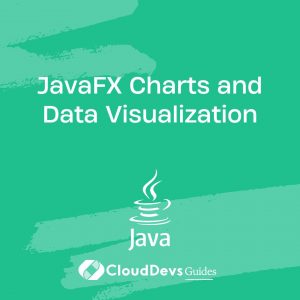JavaFX Charts and Data Visualization
In the realm of software development, the ability to present data in a visually appealing and easily understandable manner is paramount. Whether you’re analyzing financial trends, tracking user engagement, or monitoring system performance, effective data visualization can make all the difference. JavaFX, with its robust set of charting APIs and powerful graphics capabilities, emerges as a go-to solution for crafting compelling data visualizations. In this post, we’ll explore the world of JavaFX charts and delve into how they can elevate your data visualization game.
Why Choose JavaFX for Data Visualization?
JavaFX, part of the Java Development Kit (JDK), offers a wealth of features tailored specifically for creating rich, interactive user interfaces and data visualizations. Here’s why it’s a top choice for developers:
- Rich Set of Charting APIs: JavaFX provides a comprehensive suite of charting APIs, including line charts, bar charts, pie charts, area charts, and more. This extensive library empowers developers to create diverse visualizations that cater to various data types and presentation needs.
- Integration with Java Ecosystem: Being a part of the Java ecosystem, JavaFX seamlessly integrates with other Java libraries and frameworks, allowing for easy data manipulation, retrieval, and processing. This interoperability simplifies the development workflow and enhances productivity.
- Customization Capabilities: JavaFX charts offer extensive customization options, enabling developers to tailor the appearance and behavior of charts to suit specific requirements. From adjusting colors and fonts to implementing custom data markers and tooltips, the flexibility provided by JavaFX facilitates the creation of visually stunning visualizations.
- Cross-Platform Compatibility: JavaFX applications are inherently cross-platform, meaning they can run on various operating systems without requiring major modifications. This versatility ensures that your data visualizations remain accessible to a wide audience, regardless of their preferred platform.
Examples of JavaFX Charts in Action
Let’s take a closer look at some real-world examples of JavaFX charts in action:
Financial Data Visualization
Suppose you’re developing a stock market analysis tool. With JavaFX, you can create interactive line charts to display the price movements of different stocks over time. By incorporating features like zooming, panning, and data point highlighting, users can analyze trends and make informed investment decisions. Here, you can find detailed documentation and examples showcasing JavaFX chart capabilities.
Healthcare Analytics Dashboard
In the healthcare industry, visualizing patient data is crucial for monitoring health trends, identifying risk factors, and improving medical outcomes. JavaFX’s bar and pie charts can be utilized to present demographic information, disease prevalence, treatment outcomes, and more in a clear and concise manner. Interactive features such as drill-down functionality and dynamic filtering enhance the usability of the dashboard, empowering healthcare professionals to extract actionable insights from complex datasets.
Real-Time System Monitoring
JavaFX’s area charts are well-suited for visualizing real-time data streams, making them ideal for applications like system monitoring and performance analysis. By continuously updating the chart with incoming data points, developers can create dynamic visualizations that provide instant feedback on system metrics such as CPU usage, memory consumption, network traffic, and disk I/O. Integrating JavaFX with technologies like Java Mission Control further enhances the monitoring capabilities, allowing for in-depth analysis and troubleshooting.
Getting Started with JavaFX Charts
Ready to dive into the world of JavaFX charts? Here’s a brief overview of how to get started:
Set Up Your Development Environment
Ensure that you have the latest version of the JDK installed on your system. You can download the JDK from the official Oracle website or use a package manager for your operating system.
Create a JavaFX Project
Use your preferred IDE (Integrated Development Environment) to create a new JavaFX project. Most modern IDEs provide built-in support for JavaFX development, making it easy to set up project templates and configure dependencies.
Add JavaFX Chart Components
Import the necessary JavaFX chart libraries into your project and begin designing your data visualization interface. You can choose from a variety of chart types and customize their appearance and behavior according to your requirements.
Bind Data to Charts
Populate your charts with data by binding them to data models or external data sources. JavaFX supports various data binding techniques, including ObservableLists, which automatically update the chart when the underlying data changes.
Enhance Interactivity
Implement interactive features such as tooltips, zooming, and scrolling to improve the user experience and enable deeper exploration of the data. JavaFX provides built-in event handling mechanisms for capturing user interactions and responding accordingly.
Deploy Your Application
Once you’ve completed your data visualization project, package it into a standalone executable or deploy it as a web application using Java Web Start or JavaFX Packager.
Conclusion
JavaFX charts offer a powerful and flexible solution for creating captivating data visualizations that engage users and facilitate data-driven decision-making. Whether you’re building financial analytics tools, healthcare dashboards, or system monitoring applications, JavaFX empowers you to bring your data to life with stunning visualizations. By leveraging JavaFX’s rich set of charting APIs, customization capabilities, and cross-platform compatibility, you can deliver impactful data visualization experiences that set your applications apart.
So why wait? Dive into the world of JavaFX charts today and unleash the full potential of your data!
External Links:
Table of Contents









